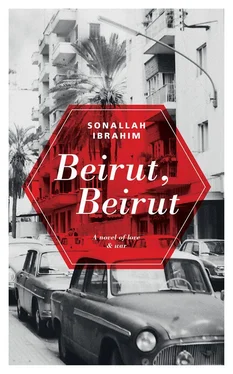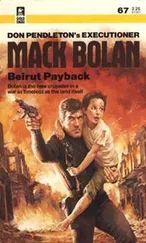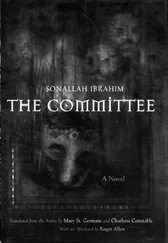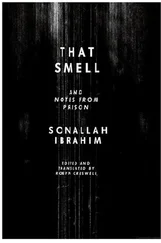The office building of the state-owned power company, in East Beirut. The camera focuses on a thirteenth-floor window.
Title card:
The president of the company, Fu’ad Bizari, a Sunni Muslim, was saved from the slaughter thanks to his solid relationship with the office of the president of the Republic, since he had previously worked as an advisor to two presidents. He telephoned an aide to President Frangieh, who immediately called the Phalangist leadership, and his life was spared.
A Beirut intersection. A handcart with three rubber wheels. Its surface is covered with dishes, cups and home appliances. Its owner pushes it quickly, bending his head to protect his wares. A powerful explosion hits him, hurling him over his cart; blood flows out of him.
Lebanese radio: “Once again, we are with you. Don’t leave your homes. All streets are unsafe.”
A Volkswagen with its flat tires sunk into the ground. Its frame is riddled with dozens of holes, all of a similar size, except in those places where two holes merge into one.
A hallway in a hospital. Groaning from the wounded. Wastepaper baskets with flies circling around them. The baskets are filled with amputated feet and bloody eyeballs.
Al-Safeer . The main headline: “Phalangist leadership confesses. The militia disobeyed orders, kidnapped and killed.”
A circle drawn in pen around a paragraph from an article in the French newspaper, Le Monde : “Saturday’s massacre took place in several Beirut neighborhoods, in an extremely organized fashion. Do they support the division of Lebanon, or are they agents of foreign powers, Israelis and Americans, as the independent Maronite leader Raymond Eddé says? Or are they extremists bringing about a smaller, Christian Lebanon?’
Barricades of mounded dirt. A young man in a military uniform is bent over a Kalashnikov machinegun. Behind him is a young man with the checkered Palestinian hatta scarf wound around his face. He is loading a Russian RPG anti-tank rocket into the launcher, getting ready to fire it. The young man is wearing a holder for other rockets on his back.
The waterfront. Fire and smoke rise up from the luxury Phoenicia Hotel.
The main headline in al-Safeer : “Lebanese National Movement forces begin clearing out the hotels district.”
The al-Mazraa Corniche. The PLO office. An armored car belonging to the Lebanese army fires at the building.
The main headline in al-Safeer : “Isolationists occupy the Ghawarna district after burning 300 homes and taking prisoner women, children and old men.”
South Beirut Mental Hospital, near the Damascus Road. Within a walled garden. Several patients with their striped clothing are walking about in the sun. The street leading to the hospital. A military car comes up at high speed and stops in front of the hospital entrance. Several gunmen emerge. They storm the hospital by force and take out a young male patient. The patient seems to have some connection to one of the gunmen. A number of patients seize the opportunity and rush outside the hospital. They walk at a rapid clip along the street leading to the city. One of them is a middle-aged man with a red skullcap on his head.
A street in central Beirut. Naked, mutilated corpses strewn at wide intervals in the middle of the road. A naked girl gushes blood from between her thighs. Beside her is a bottle whose neck is stained with blood. A young man with his genitals removed. Next to him is another young man lying on his stomach with the other’s cut-off genitals sticking out from his behind.
The street leading to the mental hospital in West Beirut. The middle-aged patient with the red skullcap hurries back to the hospital’s steel entrance gate.
A circle around a paragraph from an American newspaper: “The last few days have revealed signs of division within the ranks of the factions of the ‘national and progressive’ front in Lebanon. Rashid Karami demanded an end to the killing, even as the front announced its determination to keep fighting against the armed presence of Christians. Then a group of factions and organizations linked to Syria, in addition to ‘the Dispossessed’ — followers of Imam al-Sadr — announced their support for Karami. The Palestinian resistance seems reluctant to get involved in more killing, and thus they are making intensive efforts to make peace between Karami and Jumblatt, and resume dialogue for the sake of a ceasefire.”
A newspaper headline: “Tony Frangieh, the leader of what is called ‘The Zgharta Liberation Army’, announces: We are satisfied with our region and don’t need the capital.”
The main headline in al-Safeer : “The Palestinian resistance is making efforts to stop the killing between the populations of Zgharta and Tripoli.”
Damascus. The entrance of the presidential palace. Rashid Karami and Jules Bustani, head of Lebanon’s Deuxième Bureau, climb the stairs.
Beirut. Church bells. The headquarters of the Maronite patriarch in Bkerké. A diplomatic car flying the French flag is in front of the door.
Title card:
As usual, the French ambassador presided over the ‘‘consular’’ mass at Christmas.
Damascus Airport. King Khalid of Saudi Arabia walks down the stairway of his plane.
Title card:
Saudi Arabia, with the participation of the Gulf countries, offered 3 billion dollars to Syria as financial assistance in 1975. Syria’s estimated budget for 1967 amounted to 16 billion Syrian lira, 9 billion of which came from Saudia Arabia and the Gulf.
Main headline from a Saudi newspaper: “A spokesman for King Khalid says that Saudi Arabia supports Arab efforts to solve the Lebanese crisis by means of Syria alone.”
Damascus. The Syrian foreign minister to reporters: “Lebanon was a part of Syria. If fate allows, we will annex it.”
Beirut. Camille Chamoun to reporters: “I was hoping they might be able to regain the Golan Heights before they start thinking about annexing Lebanon.”
A page from a Lebanese newspaper with a photo of Zuheir Mohsen. Headline: “Head of the al-Sa’iqa organization warns against any major victory over the isolationists because it will invite Israeli interference.”
The main headline in al-Safeer : “The Phalangists and the Tigers, with the help of the army, storm the Dbayeh Palestinian refugee camp, 20 kilometers from Beirut. 47 inhabitants of the camp dead and wounded.”
Headline: “The small Dbayeh camp includes 20 °Christian Palestinian families.”
The main headline in al-Safeer : “Slaughter in Maslakh and Karantina; 500 killed. Phalangists announce their dominance over Karantina and the evacuation of its inhabitants.”
General shots of the shacks of tin-sheet and wood that make up the Karantina district, near the three-story “Lebanese Forces” war council building.
Title card:
Karantina had 30,000 inhabitants, most of them Kurds and poor Shiis who had fled from the south.
A posed photograph of several young men dancing over a pile of corpses. One of them is opening a bottle of champagne. In the middle of them is a young woman in a blouse and pants, strumming a guitar.
A posed photograph of men of different ages, standing with their faces against the wall of a building. Behind them are several gunmen with large wooden crosses dangling from their necks.
A posed photograph of a procession of women and children carrying white flags. There isn’t a single grown man among them.
The “Sleep Comfort” furniture factory.
Title card:
Inside this factory, several dozen Palestinian gunmen, residents of Karantina, were dug in, and they held out against the Phalangists for three days until they were killed down to the last man.
Читать дальше












